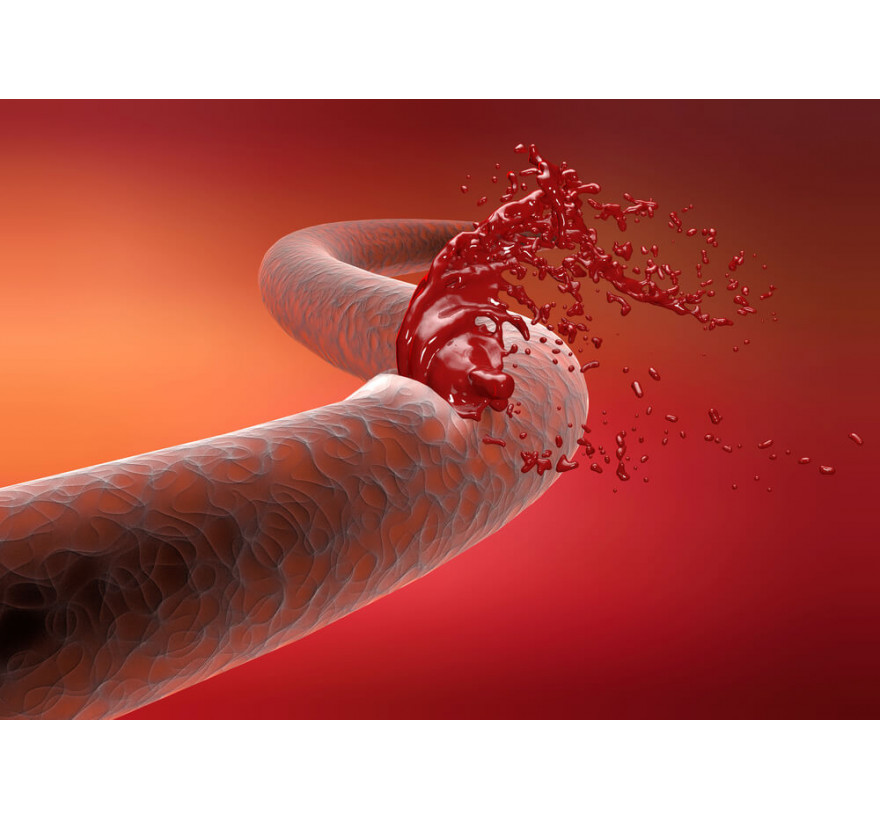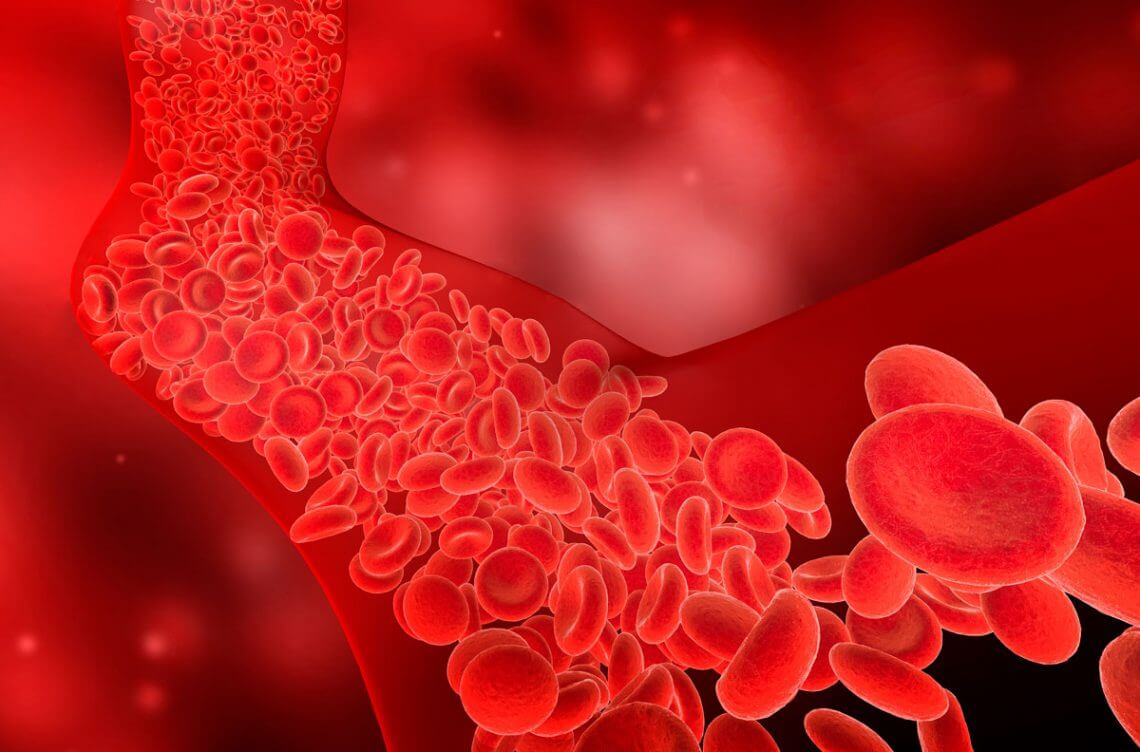What is coagulopathy?

In a normal state, a sufficient amount of hemoglobin protein, platelets and red blood cells circulate in the body, in dynamic equilibrium. With open bleeding, the body starts a process called coagulation so that the blood coagulates and is delivered to the site of injury, stopping the bleeding.
Clogging of the wound occurs with the help of sticking platelets, which replace the damaged walls of blood vessels and arteries.
ICD-10
According to the classification of coagulopathy according to the International Classification of Diseases, coagulopathy belongs to the class "Blood coagulation disorders, purpura and others", encoded D65.
Types of coagulopathy
The occurrence of blood coagulation abnormalities has many different causes, but is divided into types solely by the method of occurrence. Two main types of coagulopathy are distinguished:
Progressive throughout life. Pathology is acquired with the development of diseases, and is a complication against the background of another disease, being one of the symptoms.
Mostly coagulopathy is observed in infections caused by bacteria and tumor formations of a malignant nature. Also, coagulation disorders can cause some medications.
Transmitted from mother to child. In this case, the pathology is congenital, and the violation occurs at the level of homeostasis. The qualitative composition of the shaped elements is affected by a decrease in the saturation of biologically active substances in the blood.
A malfunction occurs in the platelet formation system. Hereditary coagulopathies are divided into forms, depending on the absence of one or another component, with the formation of a blood clot.
With extensive blood loss, the body cannot quickly restore normal quantitative concentration of the formed elements, which leads to a decrease in blood coagulation and leads to coagulopathy.
Hereditary pathologies contain all forms of increased bleeding.
Loss of blood and cardiac arrest leads to death of patients without taking effective therapy.
The common name for all forms of congenital coagulopathy is hemophilia.
And are characterized by insufficient saturation with thromboplastins.
The congenital form is subdivided into another three types, according to blood coagulation factors:
Group A. This subspecies is characterized by insufficient saturation with antihemophilic globulin,
Group B. It is characterized by deviations in the balance of Christmas factor (coagulation factor IX, protein alpha-globulin),
Group C. Progresses on the background of an insufficient amount of factor IX, which precedes thrombolastine.
Symptoms in the development of various forms of congenital pathology are not significantly different. The first two forms affect only the male sex, a consequence of the transmission of the disease from a woman, the X chromosome affects this.
The last form (group C) can affect both men and women, this coagulopathy is not associated with chromosomal inheritance.
Developing during life, include a large number of different conditions that manifest themselves in the form of coagulation disorders and bleeding. Gender does not play a role, it is mainly associated with genetics.
At some points, coagulopathy may be due to the production of a small amount of prothrombin.
Its formation occurs in the intestine, with the help of vitamin K, bile and gastric juice.
With intestinal pathologies, infectious lesions, a lack of vitamins in the liver, all this leads to a reduced formation of prothrombin, or the process of absorption by its body is disrupted.
In many cases, coagulopathy is associated with a high concentration of fibrin in the blood, which leads to a decline in fibrinogen. All this leads to thrombocytopenia (a decrease in platelet count), which in turn provokes increased bleeding.
What causes low blood coagulability?
All varieties of low coagulability are rapidly progressing in the body.
The following factors can provoke coagulopathy:
Malfunctioning hormones
The death of liver cells (cirrhosis), a lack of fat in the liver,
All types of hepatitis,
Thrombus formation
Poisoning with plant and animal poisons, heavy metals,
Prolonged use of anticoagulants (prevent the formation of blood clots, and inhibit the immune system),
Pathologies in which the thickness of the walls of the vessels decreases,
Low concentration of vitamin K (found in spinach, tomatoes, soybeans, beef),
Failures of the processes of absorption of substances in the intestine,
Tumor formations of malignant and benign characters.
An exacerbation of less blood coagulation occurs when bacteria and viruses are present in the body.

One of the sharp exacerbations occurs with kidney failure. Since, at this moment, the blood is filtered less, and there is a greater accumulation of toxins and toxins that stagnate in the blood.
During periods of gestation, when an enlarged uterus presses on the urethra and the kidney is under load, often reduced blood filtration in the kidneys and stagnation of toxins are recorded. Restore healthy blood circulation helps bed rest.
How to identify the symptoms?
Symptoms are the same for both types of coagulopathy. The exact diagnosis is made by a qualified doctor.
If the following symptoms are identified, you should contact a hospital examination:
When large hematomas form, from bruises of a weak nature,
Increased hemorrhages both on the skin and in the mucous membranes,
Nails become more fragile, hair falls out and teeth become deformed.
Cyanosis of the hands and the area under the nose,
Symptoms of Anemia
Pale skin tone
In severe cases, hemorrhagic shock,
Ischemia of the internal organs,
Long healing of wounds (a long process of coagulation), which are not affected by either peroxide, or brilliant green, or iodine.
Prolonged blood loss leads to the loss of large amounts of vitamin B and iron.
In childhood, coagulopathy is very dangerous, since a large amount of vitamins and iron are needed at the stage of body formation.
What happens during pregnancy?
Mostly coagulopathy develops in pregnant women with the occurrence of certain pathologies presented below:
Disease of the circulatory system and the formation of blood cells,
Diseases projected by a lack of vitamins in the body,
Varicose veins,
Thrombophlebitis of a chronic nature (it is an inflammation of the venous walls, with the formation of blood clots in them).
Women who have significant blood loss in the past, with weights from thromboembolism, are at greater risk. People suffering from diabetes are also prone to developing coagulopathy.
Such women should be monitored by a doctor throughout the pregnancy period, regularly taking tests and examinations, as well as taking prescribed courses of therapy. In most cases, such expectant mothers are placed in a hospital for the entire duration of their pregnancy.
Establishing diagnosis
Initially, you need to go to the doctor for an examination. At the first meeting, he listens to the patient’s complaints and performs an initial examination, studies the anamnesis. Then, in case of suspicion of coagulopathy, the doctor will send for blood tests (clinical and biochemical), as well as a urinalysis.
If the results of a urinalysis contain a large amount of calcium, there are suspicions of the presence in the body of tumor formations of a malignant nature, which lead to bleeding.
If a large amount of proteins is found in the urine, then an ultrasound of the kidneys is performed to determine their performance and activity.
Among blood tests, the main stages are noted, which doctors pay attention to:
An analysis of the concentration of fibrinogen in the blood, which in the case of coagulopathy, is marked by a decrease,
The hemorrhage time, which in the case of pathology, is many times higher than the norm, is measured,
The number of platelets in the blood, with pathology is much lower than normal,
The main blood factors are determined.
Due to the fact that coagulopathy can be only one of the symptoms of the disease, an examination of the body is carried out to identify the pathology of organs, blood and blood vessels.
Among them:
Clinical blood test. It will show the general state of the patient’s health, and deviations from normal indicators of elements that saturate the blood. Determines the development of coagulopathy. In blood tests, a low concentration of hemoglobin, red blood cells, and platelets can indicate coagulopathy. Blood is taken from a finger or vein in the morning and on an empty stomach,
Blood chemistry. An extensive blood test that will help determine the condition of almost all organs of the body. By fluctuations in indicators in one direction or another, it is possible to determine not only the affected organ, but also the extent of its damage. They give such an analysis on an empty stomach, in the morning, providing blood from a vein or finger,
Blood coagulation analysis (coagulogram). Certain studies aimed at determining blood coagulation. Using the analysis, the ability and efficiency of coagulation is evaluated. Blood donation occurs, as in biochemical analysis,
General urine analysis. Doctors diagnose kidney damage factors by monitoring the level of protein and red blood cells in the urine,
Ultrasound examination (ultrasound). A study with which you can visually see the state of organs and blood vessels, and notice deviations in them,
X-ray studies,
MRI (magnetic resonance imaging). Gives full information on the state of the body. But it is a very expensive analysis.
The choice of the study is at the discretion of the doctor, taking into account additional symptoms and complaints of the patient.
How is low coagulability treated?
For an effective course of treatment, it is necessary not only to constantly take medications, but also to lead a healthy lifestyle and follow a diet. The main goal of therapy is to eliminate the cause that caused the disease.
In the event of severe injury, a patient with coagulopathy needs urgent hospitalization. In intensive care, they fill up the lost blood with the help of special solutions in the form of droppers. For large blood losses, transfusion of compatible donated blood is done.
To normalize coagulation to the desired level, mainly certain medications are used:
Iron-containing preparations (Fenyuls, Sorbifer),
Antibiotics (clarithromycin, amoxiclav, amoxicillin),
Chemotherapeutic agents
Plasma substitutes,
The use of complexes of vitamins and minerals,
Antispasmodics (Drotaverinum, Spazgan),
Glucocorticosteroids (Dexamethasone, Prednisolone).
To stop open bleeding in a patient with coagulopathy, a homeostatic collagen sponge or powder is used. If they do not bring effect, then remove the spleen, by surgery.
It is also recommended to remove heavily overcooked, spicy, salty foods from the diet, as well as get rid of alcohol.
Preventive action
There are no special measures for the prevention of coagulopathy.
Doctors recommend that you follow these recommendations in order to prevent clotting disorders as much as possible:
Regular examinations,
Healthy lifestyle.
Avoidance of traumatic situations. Possible injuries must be prevented, as bleeding stops slowly. And big injuries, with coagulopathy I can lead to disastrous consequences,
Proper nutrition. Another key to the prevention of many diseases is a balanced, healthy diet. You should eat foods that are rich in vitamin K (spinach, soy, strawberries, potatoes, veal, tomatoes, cod, cauliflower, rosehip).
The key to the prevention of most of all diseases is maintaining a healthy lifestyle and a balance between work and good rest.
Following these simple guidelines will help prevent bleeding disorders. And will help its effective treatment.
What is the forecast?
With timely access to the hospital, proper examination and taking an effective course of complex therapy, the outcome is favorable. The coagulation level is successfully supported by medications.
If coagulopathy is a symptom of another disease, then the course of treatment is aimed at eliminating the root cause. A healthy lifestyle, a proper diet and rejection of bad habits will help not only to normalize coagulation, but also to prevent coagulopathy.
If you do not pay attention to the symptoms and ignore the visit to the doctor, then this can lead to disastrous consequences. With medium-sized wounds, heavy bleeding occurs, which is very difficult to stop, which can lead to large losses of blood, and cardiac arrest.
If you find any symptoms - consult a doctor! Do not self-medicate and be healthy!
